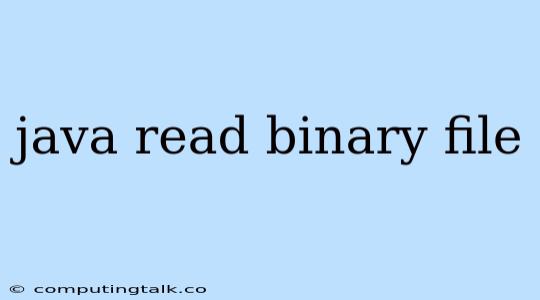Reading binary files in Java is a common task that involves working with raw data in its binary form. This can be essential for various purposes, from handling image files to working with serialized data. Let's explore how to effectively read binary files in Java.
Understanding Binary Files
Before diving into code, it's crucial to understand the nature of binary files. Unlike text files, which store human-readable characters, binary files store data in a way that computers understand directly. This data can represent anything from images, audio, video, to complex data structures.
The FileInputStream Class
The core of reading binary files in Java lies in the FileInputStream class. This class provides methods for reading data from a file as a stream of bytes. Here's a basic example:
import java.io.FileInputStream;
import java.io.IOException;
public class ReadBinaryFile {
public static void main(String[] args) {
try (FileInputStream fileInputStream = new FileInputStream("path/to/your/binary/file.bin")) {
int byteRead;
while ((byteRead = fileInputStream.read()) != -1) {
System.out.print(Integer.toHexString(byteRead) + " ");
}
} catch (IOException e) {
System.out.println("Error reading file: " + e.getMessage());
}
}
}
This code reads the bytes from the specified file and prints their hexadecimal representation.
Reading Specific Data Types
Often, you need to read specific data types from the binary file, such as integers, floats, or strings. Java provides classes for handling these data types, and you can use DataInputStream to read them from the FileInputStream.
import java.io.DataInputStream;
import java.io.FileInputStream;
import java.io.IOException;
public class ReadBinaryFileWithDataTypes {
public static void main(String[] args) {
try (FileInputStream fileInputStream = new FileInputStream("path/to/your/binary/file.bin");
DataInputStream dataInputStream = new DataInputStream(fileInputStream)) {
int integerValue = dataInputStream.readInt();
float floatValue = dataInputStream.readFloat();
String stringValue = dataInputStream.readUTF();
System.out.println("Integer: " + integerValue);
System.out.println("Float: " + floatValue);
System.out.println("String: " + stringValue);
} catch (IOException e) {
System.out.println("Error reading file: " + e.getMessage());
}
}
}
This example reads an integer, a float, and a UTF-8 encoded string from the binary file.
Reading a Fixed Number of Bytes
Sometimes, you need to read a specific number of bytes from the file. The read(byte[] buffer, int byteOffset, int byteCount) method of FileInputStream allows you to do this:
import java.io.FileInputStream;
import java.io.IOException;
public class ReadFixedBytes {
public static void main(String[] args) {
try (FileInputStream fileInputStream = new FileInputStream("path/to/your/binary/file.bin")) {
byte[] buffer = new byte[10]; // Read 10 bytes at a time
int bytesRead;
while ((bytesRead = fileInputStream.read(buffer)) != -1) {
System.out.println("Read " + bytesRead + " bytes:");
for (byte b : buffer) {
System.out.print(Integer.toHexString(b) + " ");
}
System.out.println();
}
} catch (IOException e) {
System.out.println("Error reading file: " + e.getMessage());
}
}
}
This code reads 10 bytes at a time and prints their hexadecimal values.
Handling Exceptions
Remember that file input operations can throw exceptions, especially IOException. It's essential to handle these exceptions appropriately. The try-with-resources block ensures that the FileInputStream is automatically closed after use, even if an exception occurs.
Best Practices
- Use
DataInputStreamfor reading specific data types. It provides methods for reading integers, floats, strings, and more. - Close resources (streams) properly. Use
try-with-resourcesto ensure automatic resource closure, even if exceptions occur. - Consider using
BufferedInputStreamfor improved performance. This can buffer the data, reducing the number of read operations from the underlying file. - Understand the file structure. Before reading the file, ensure you know the data layout and how it's organized.
Conclusion
Reading binary files in Java empowers you to work with raw data in its binary form. Understanding the concepts of FileInputStream, DataInputStream, and exception handling is crucial for handling binary data effectively. By using best practices and being aware of potential issues, you can confidently read and manipulate binary files in your Java applications.
